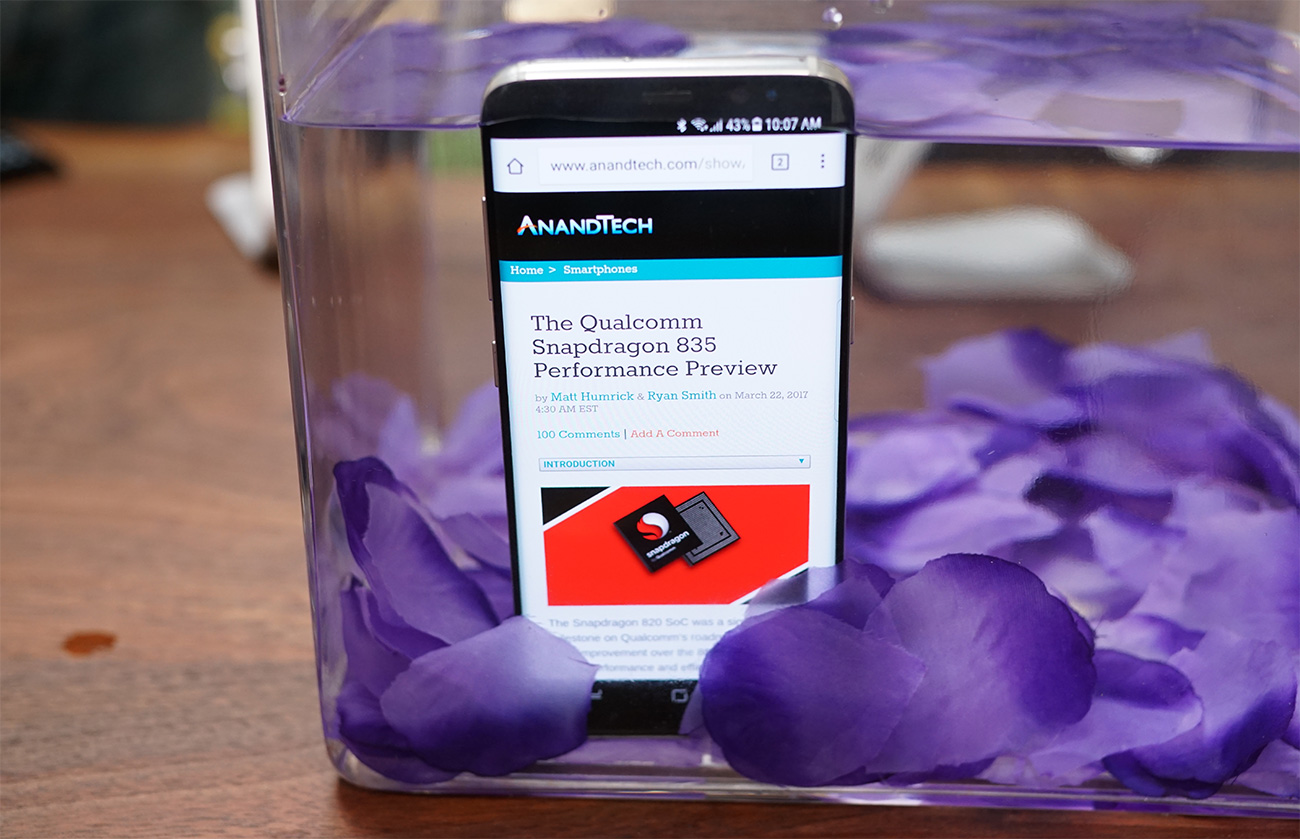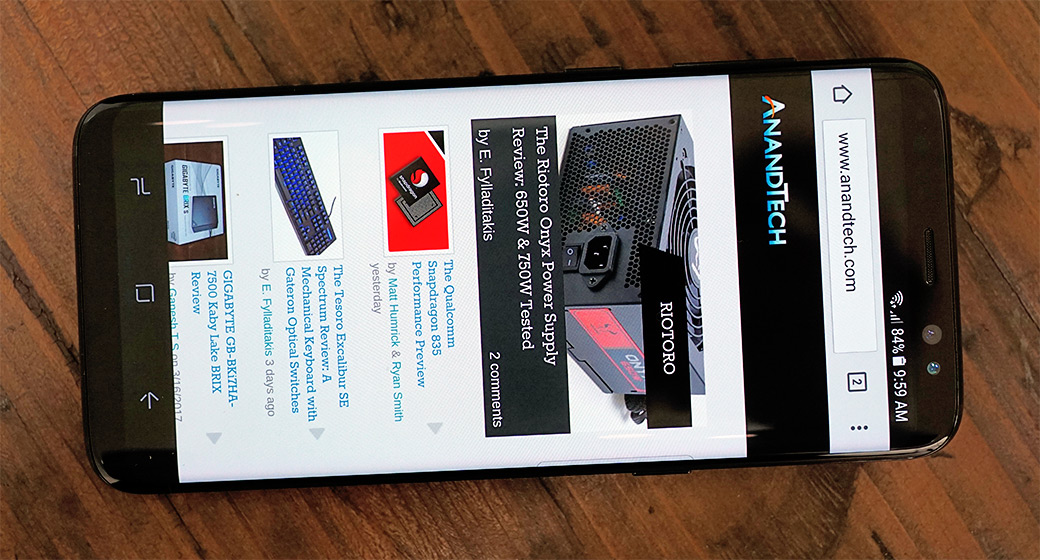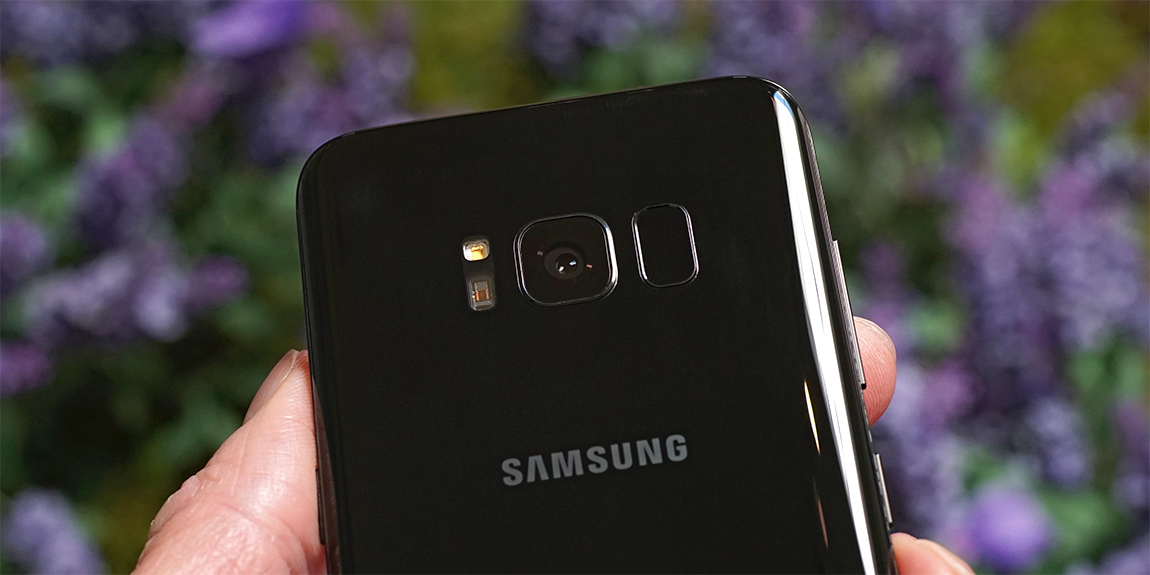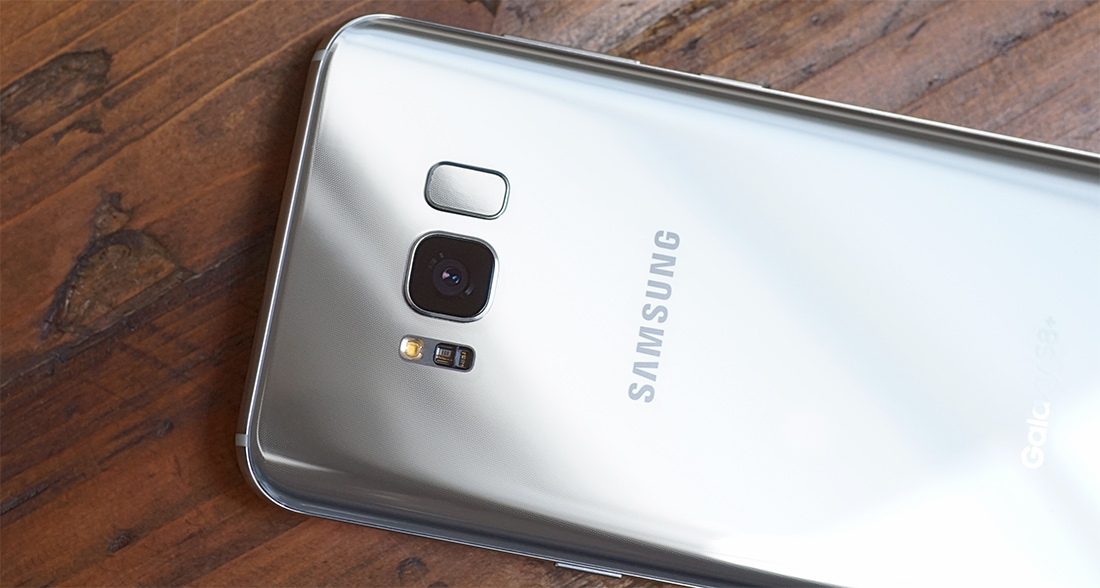Hands On With Samsung's Galaxy S8 and S8+: Taller Screens and Slimmer Bezels
by Matt Humrick on March 29, 2017 11:00 AM EST- Posted in
- Smartphones
- Samsung
- Galaxy
- Mobile
- Galaxy S8
Internal Hardware and Features
Inside the redesigned Galaxy S8 and S8+ is either a Qualcomm Snapdragon 835 or Samsung Exynos 8895 SoC. The US and other regions that require CDMA capability will get the Snapdragon 835. We already have some idea of what to expect from the 4x4 big.LITTLE Kryo 280 CPU and upgraded Adreno 540 GPU after some preliminary performance testing. We know less about the Exynos 8895, which the rest of the world will receive. When we spoke with Samsung LSI at MWC 2017, a representative told us that while the 8895 comes with a Mali-G71MP20 GPU, the GPU configuration and operating points are set by the OEM, meaning it’s possible the S8 will not use all 20 GPU cores.
| Samsung Galaxy S8 Series | ||
| Samsung Galaxy S8 | Samsung Galaxy S8+ | |
| SoC | Qualcomm Snapdragon 835 (US, China, Japan) 4x Kryo 280 Performance @ 2.35GHz 4x Kryo 280 Efficiency @ 1.90GHz Adreno 540 Samsung Exynos 8895 (rest of world) 4x Exynos M2 @ 2.30GHz 4x Cortex-A53 @ 1.70GHz ARM Mali-G71 |
|
| Display | 5.8-inch 2960x1440 (18.5:9) SAMOLED (curved edges) |
6.2-inch 2960x1440 (18.5:9) SAMOLED (curved edges) |
| Dimensions | 148.9 x 68.1 x 8.0 mm 155 grams |
159.5 x 73.4 x 8.1 mm 173 grams |
| RAM | 4GB LPDDR4 (US) | |
| NAND | 64GB (UFS 2.1) + microSD |
|
| Battery | 3000 mAh non-replaceable |
3500 mAh non-replaceable |
| Front Camera | 8MP, f/1.7, Contrast AF | |
| Rear Camera | 12MP, 1.4µm pixels, f/1.7, dual-pixel PDAF, OIS, auto HDR, LED flash | |
| Modem | Snapdragon X16 LTE (Integrated) 2G / 3G / 4G LTE (Category 16/13) Samsung LTE (Integrated) 2G / 3G / 4G LTE (Category 16/13) |
|
| SIM Size | NanoSIM | |
| Wireless | 802.11a/b/g/n/ac 2x2 MU-MIMO, BT 5.0 LE, NFC, GPS/Glonass/Galileo/BDS | |
| Connectivity | USB Type-C, 3.5mm headset | |
| Features | fingerprint sensor, heart-rate sensor, iris scanner, face unlock, fast charging (Qualcomm QC 2.0 or Adaptive Fast Charging), wireless charging (WPC & PMA), IP68, Mobile HDR Premium | |
| Launch OS | Android 7.0 with TouchWiz | |
The new SoCs are paired with 4GB of LPDDR4 RAM, the same amount that’s in the Galaxy S7, S7 edge, and most other flagship phones. Internal storage is limited to 64GB with the option to add additional capacity via microSD card. While this will be enough to satisfy most people, it would be nice to see a 128GB option for a flagship in this price bracket.
Even though overall size and thickness have increased slightly compared to the previous generation, battery capacity has not improved. The Galaxy S8 comes with a 3000mAh battery, the same size as the Galaxy S7, while the S8+ comes with a 3500mAh battery, slightly less than the S7 edge’s 3600mAh capacity. It will be interesting to see how battery life compares, considering the S8s’ larger screens contain nearly 16% more pixels, increasing power consumption if not offset by panel efficiency improvements or power savings elsewhere, such as the new 10nm SoCs. Regardless, it’s disappointing that Samsung is still prioritizing thickness over battery life.
The overall camera experience has been a differentiating feature for the past couple of Galaxy generations. Samsung gave the S7 and S7 edge a new 12MP rear camera last year that improved low-light image quality. It was also the first phone camera to use dual-pixel PDAF, which vastly improves autofocus performance by using every pixel for phase detection instead of just a handful of phase detection pixels scattered across the sensor.
While most flagships—and even some mid-range phones—are moving to dual-cameras and adding hybrid AF systems to improve performance and attract consumers’ attention, Samsung is content to reuse the S7’s rear camera for the S8 and S8+ but with updated image processing software. We’ve grown accustomed to seeing a new camera every year, but the S7’s (and now S8’s) camera is still among the best available for phones. Its combination of features (object-tracking AF, auto HDR, HDR live preview, manual mode, 2160p30/1080p60 video), quick performance (camera launch, image capture, AF, HDR processing), and excellent image quality add up to a great overall camera experience. Adding a second sensor could enable additional features, such as depth sensing for bokeh effects, or further improve image quality, but Samsung is either not willing or ready to travel that path yet.
The S8 and S8+ do get a new front-facing camera, however. The higher-resolution 8MP sensor is paired with a fast f/1.7 lens that’s capable of shooting up to QHD (2560x1440) video, although HDR, EIS, and video effects are deactivated in this mode. Samsung’s Smart AF feature uses face detection and contrast-based AF to improve image focus for selfies.

The Galaxy S8 and S8+ have an IP68 rating for water and dust resistance, so you can read AnandTech in the bath.
The new Galaxy phones come with Android 7.0 and Google Assistant. TouchWiz gets a facelift with more rounded corners to match the screen, but the most interesting new software feature is Bixby, Samsung’s new virtual assistant. This “intelligent user interface” promises expanded voice navigation, allowing you to (eventually) substitute voice commands for any touch-based actions. It’s deeply integrated into the OS already, and Samsung has an SDK available for third-party developers.
There’s more to Bixby then just telling your phone to adjust the screen brightness or open an app, however. Tapping the Bixby button in Samsung’s Camera app activates Bixby’s object recognition capabilities, allowing it to scan QR codes, process business cards, perform language translation, and provide product information and shopping links. It also learns your habits over time and provides context relevant information, reminders, and suggestions. For example, if you call your significant other on your drive home every day, Bixby will recognize this and offer to automatically dial his/her number for you. Bixby is still a work in progress, though, and it’s not clear how many of its features will be functional when the phones begin shipping.
Samsung is also announcing some new accessories alongside the Galaxy S8 phones. There’s a new version of Gear VR that’s compatible with the S8, S7, S6, and Note5 families. First announced at MWC 2017, this new model comes bundled with a touchpad controller that also enables hand tracking. Samsung’s Gear 360 VR camera also gets a refresh. It’s now capable of recording 4096x2048 H.265 video at 24fps, a slight increase over the previous version’s 3840x1920 resolution at 30fps.
Samsung's DeX docking station is a productivity-focused accessory that allows a Galaxy S8 phone to drive a desktop experience. The puck-shaped cradle includes an HDMI port, two USB 2.0 ports, and a 100Mbit/s Ethernet port for connecting the phone to an external monitor, keyboard, mouse, and wired network. The phone’s external speaker provides sound.
Instead of a stretched-out phone UI, the S8 provides a desktop environment with support for multiple, resizable windows, copy and paste between windows, and an app drawer for accessing all the Android apps installed on the phone.
The Galaxy S8 and S8+ will be available in US stores beginning April 21 and will come with Harman AKG earbuds. Pre-orders will begin at 12am ET on March 30. As an additional incentive, customers who pre-order the S8 or S8+ will receive a Gear VR with Controller for free. There’s also a premium bundle that throws in a 256GB microSD card and AKG Bluetooth headphones for an additional $99. Colors for the US include Midnight Black, Orchid Gray, and Arctic Silver. Coral Blue and Maple Gold colors will also be available in select markets. In the US, the Galaxy S8 will retail for $750, while the S8+ will cost $850.
The new Samsung Gear VR with Controller will also be available on April 21 for $129.99. The Controller can be purchased separately for $39.99.













208 Comments
View All Comments
arayoflight - Wednesday, March 29, 2017 - link
Audio will be nice I guess. All the exynos models always had the wolfson DAC. Qualcomm versions traditionally blow though. Storage space is plenty with the 64GB base option with microSD slot.It's a pass for me too, with that mediocre battery capacity and the same camera. But the rest of the phone looks awesome. UFS 2.1 storage too seems nice.
more-or-less - Wednesday, March 29, 2017 - link
Who the 'eck needs dual cam? Do you see professional grade camera or any cameras using dual sensor? Just because apple shoved up your arse doesn't mean everyone wants a dual cam. A good single sensor is way better than crappy dual sensor. Idiots like you rest of humans look dumb as fuck.osxandwindows - Wednesday, March 29, 2017 - link
So, how's the pay?halcyon - Wednesday, March 29, 2017 - link
I've used Mate9 with dual camera and it's really nice. And superior in zoom, in b/w photography and also excellent in low-light if you use manual mode.Further, Huawei already ships 128GB and 256GB internal flash models along with microsd-card slot. I can easily max out the 64GB on my phone (and I already have a 256GB sdcard).
Yes, I'm a power user. Go ahead, sue me :-D
lilmoe - Wednesday, March 29, 2017 - link
hmmmm. The phone is pretty darn impressive though, and will most probably be the best in 2017 until the Note8 is announced. The crap load of leaks took too much of the excitement away, since we already knew everything about it.About the specs....
- Processor: This is as good as it will get this year for the SoC. I don't believe anything better will come out, definitely not from Apple at least (might be contempt with fixing their cluster migration issues and go HMT).
- Screen is the absolute best. AMOLED+ is back. Hope to see better upscaling of lower resolution presets.
- Build is stunning.
- Radio stack should be the best in the business.
- Software and hardware processing improvements in the camera, probably same sensor (still best in class).
- We still have no information about the speaker and DAC. Seemed much loader and fuller from what I've heard from the DaX demo. Will have to see reviews and test it in hand.
- Battery life needs to be tested.
- User interface is awesome.
- I wouldn't call Bixby a work in progress. I believe they totally nailed what I want from voice interaction. Very nice.
Would I upgrade? Most probably not (unless I find a massive discount by the end of the year). Pretty sure most of the software improvements and Bixby will find its way to my Exynos GS7, which is already better than anything out there especially after the Nougat update (including the G6 from LG). I mostly use my camera in manual mode anyway (lowest ISO possible) which takes photos much, MUCH better than anything out there.
I would have been more enticed to upgrade if:
- the processor had an improved little cluster (efficiency cores). I was hoping they'd have swapped the A53s with Exynos M2 cores optimized for lower frequency and much lower power consumption. 10nm would have made that possible and a bit more feasible, I believe.
- an even better ISP that allowed a larger 16-18mp camera sensor (larger in both size and pixel count) with more improved noise processing and super sampling of the entire image for video (whole sensor readout). They're currently keeping it at 12mp to keep the image processing as optimal as possible for video, without needing to crop the image or do any form of pixel binning.
- A f1.4 lens. Even better, I wonder of they can pull off a retractable zoom lens (18-55 or 24-70mm at fixed f1.4 aperture) in the same form factor, where the lens retracts to sit flush with the back when the camera isn't active. THAT would be the next revolution smartphone photography without needing any dual sensor gimmicks. But I guess they'll need to invent in nano gear for that.
Meteor2 - Wednesday, March 29, 2017 - link
Yes I was surprised to see A53 cores *still* knocking around in there. Perhaps the A35 just isn't significantly more efficient. It's probably only a a few percent better for something that does only a few percent of the total CPU work.lilmoe - Thursday, March 30, 2017 - link
The small cluster does most of the work actually.negusp - Thursday, March 30, 2017 - link
"Build is stunning"? You mean a thin glass brick?And, until Samsung ditches their policy of never releasing kernel source for their devices, they're pretty much worthless as a company to me.
lilmoe - Thursday, March 30, 2017 - link
I was obviously talking about the design. The form factor, the front and the screen that assimilates with that front (especially in the dark), the sides and the chrome finish of the metal frame are all absolutely gorgeous.I just wish there was a "Classic" variant with a semi-rubberized plastic back and a removable battery... They can do this with water resistance just like the GS5. I would have probably argued that there wasn't enough demand for that now, but we do have the relatively unpopular Active series, right?. Common Sammy :(
"And, until Samsung ditches their policy of never releasing kernel source for their devices, they're pretty much worthless as a company to me"
The wont because of Knox and other reasons, but I don't want them to. You shouldn't either. This just means that backdoors and security holes will be that much easier to find. At this point, there software is already comprehensive that it isn't worth rooting anymore, risking bricking or instability...
If you're dead set on custom firmware for whatever, this isn't your phone.
Meteor2 - Thursday, March 30, 2017 - link
It's £689 in the UK. That is a ridiculous price. I was surprised to see Google is still charging £599 for the Pixel when I checked just now, too.I know several people with iPhone 7s and a few with Nexus phones. The rest generally use old (2+ years) Samsungs or iPhones. I've never seen a Pixel. I do wonder if we are hitting or even passing the limit of what people are prepared to pay for something which, after all, weighs less than 160g.
The specifications and tech in this phone is first class... But you'd be mad to buy it over a OnePlus.